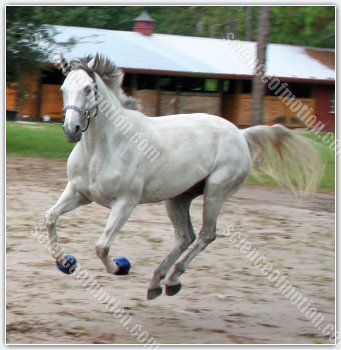plasticity of muscles
Plasticity of Muscles

In 2003, equine research studies explored the “plasticity of muscles’ function.” Further investigating muscles’ architecture and function, pertinent researches demonstrated a much advanced usage of elastic strain energy through the whole muscular system. Muscles are composed of cells and connective tissues often referred to as “tendinous material” and elastic strain energy occurs within the muscle in the absence of tendon. In artificial situation such as high speed treadmill, where evenness of the ground and speed are constant, muscles tend to operate in isometric contraction, and just hold, allowing connective tissue to be loaded with elastic strain energy. It is very economical to just turn on but not shorten, because the real energetic cost of using muscle is in forming the myosin cross bridges. When you only turn on once, they all stay in place and no more cellular energy is needed. They provide inexpensive support that can be switched on constantly without exhausting the owner. This concept is widely used throughout the body where constant support is needed such as the main back muscles.
The concept is theoretical. Any back muscles imbalance, or uneven ground or never the less performance, demands adapting the creation of forces through the muscle cells and therefore concentric or eccentric contractions. However, the fact that the connective tissue within the muscles can be loaded with elastic strain energy suggests much greater influence of the rider’s movements than previously believed. In 1964, Estienne Saurel wrote, “Undoubtedly any shift of the rider’s weight is important for balancing the horse for controlled movements.” (Pratique de l’ équitation d’ après les maitres français. Flammarion, Paris) By contrast, in 2013, advanced understanding of the equine physiology demonstrates that undoubtedly, any shift of the rider’s weight handicaps the horse’s ability of mastering balance control and performances. Uneducated trainers promote mobility, via relaxation and swing the rider’s back. Antiquated riding and training techniques emphasize shifting the rider’s weight driving the horse forward onto the bit. At the contrary, modern science exposes the disturbances that these primitive techniques create loading the tendinous components of the horse’s back muscles with chaotic elastic strain energy.
Superficial theories have always been and continue to be the major cause of equine injuries. Since we have approached the long and low heresy, studying in details the architecture and function of the horse’s upper neck muscles, the subject of the lowering of the neck can be pushed a little further illustrating the dangers of ignorance. Truly, long a low is more a cult than a training technique since it is based on faith instead of factual documentation. Facts are contradicting all the claims made by long and low proponents but the faith persist. The faith persists because the theory feeds superficial impressions, visual as well as sensitive. Anxious to protect their faith, long and low proponents dismiss as unimportant the fact that the lowering of the neck increases the weight on the forelegs. The dismissal is literally a betrayal since increasing load on the forelegs is the leading cause of equine injuries. Scientific studies now explains than before becoming arthritic or other problems at the level of the cartilages of the joints, lesions occur within the bone itself below the cartilages. Crack or micro-fractures are the first step of a process that will alter the joints and these lesions are created by excessive stresses.
While training techniques loading the forelegs are exposing the horses to injuries, at the contrary, riding and training techniques developing and coordinating the horse’s physique for real balance control and therefore less weight on the forelegs, help preventing such injuries. Advanced studies also explain why damages can be prevented reducing the load on the front limbs. The ability of bone cells to produce bone seams in confined spaces is nothing less than wonderful. Such cementing capacity is optimal when the athlete is under regular work and the bone under regular and positive stress. An even more interesting finding is that the repair mechanism of cancellous bones is in preventing rather than curing damages. Training techniques based on simplistic theories such as rushing the horse on the forehand and/or lowering the neck,damage the horse’s bone structure. By contrast riding and training technique updated to modern understanding of the equine physiology, prevent injuries.
Jean Luc Cornille
Science Of Motion


